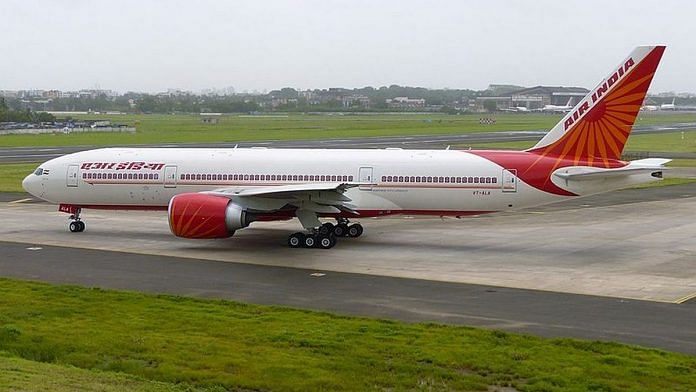New Delhi: Air India’s dwindling Boeing 777 fleet was dealt a fresh blow Wednesday night when one of its aircraft caught fire during routine maintenance at Delhi’s Indira Gandhi International Airport — the fourth Air India 777 to go out of service in about a month.
The auxiliary power unit (APU) of the B777-200LR aircraft, registration code VT-ALF, caught fire during maintenance work on an air conditioner when it was being prepared for the non-stop Delhi-San Francisco flight, one of the longest in the world. Air India officials termed it ‘a minor accident’.
“Yesterday night at Delhi when an engineer was doing routine technical examination of an empty aircraft (777), APU auto shut down took place. Airport fire personnel observed black fumes from the APU exhaust and believing it to be a fire hazard sprayed APU and part of the fuselage with foam spray,” a statement from the airline read.
Boeing India has not yet responded to queries sent by ThePrint. This report will be updated when it does.
Funds are the problem, not age
Air India owns 18 Boeing 777s — 15 777-300ERs and three 777-200LRs. Three of them have been grounded for about a month due to lack of funds for maintenance.
“There were no funds to buy spare parts and continue operating these aircraft. However, now, we are simultaneously buying spare parts and collecting them in order to bring the grounded B777s back to the fleet in another month’s time,” an Air India source told ThePrint.
According to another Air India official, talks are also on between the national carrier and the State Bank of India to operate aircraft in five international sectors that were flown by Jet Airways before financial problems forced the grounding of the airline.
Jet owns 10 Boeing 777-300ERs, and the official said Air India is planning to take these aircraft on lease from SBI.
Pilots say the issue is not the quality of the aircraft or the age — the one that caught fire Wednesday is just eight years old. Captain N.K. Beri of Air India said the shelf life of a Boeing 777 is more than 25-30 years. “There are jumbos (747s), which are 50 years old and still operational,” he said.
In September 2018, Air India’s flagship flight AI 101 between Delhi and New York — operated by a nine-year-old Boeing 777-300ER — suffered a multiple system failure, forcing an emergency landing that was labelled ‘miraculous’.
Captain Rustom Palia, who commanded the flight and received widespread commendation for the landing, told ThePrint that the problems are due to funds, rather than the planes “falling apart”.
“As long as the aircraft are maintained properly, they can continue to fly. But aircraft maintenance is an expensive business, so it’s more to do with finances and nothing to do with the 777s falling apart,” Palia said.
Charles Price, another B777 pilot with an international carrier, said: “If Air India does not have funds to buy spare parts, that’s not an aircraft problem. All aircraft require spares on a day-to-day basis, maintenance is usually done by exchanging units and sending the used part back for overhaul. If Air India doesn’t have funds for spares, it could go the same way as Jet Airways.”
Also read: Air India halves luggage allowance on Mumbai-NY route as Pakistan airspace closure continues
Air India’s financial troubles
Air India has a debt burden of Rs 55,000 crore. The ministerial panel headed by Finance Minister Arun Jaitley had approved the sale of the carrier’s subsidiary, Air India Air Transport Services, while there were also plans to sell another subsidiary, Air India Engineering Services, in order to lower the debt burden of the airline. In 2018, Air India had even invited bids to sell its properties across the country.
In its annual report for 2017-18, Air India had already stated that to turn its performance around, it will phase out its old fleet. This, it said, would reduce maintenance costs, which would be followed by a reduction in contractual employment and outsourced agencies. It had also said it would introduce a brand new fleet on several domestic and international routes, thereby increasing passenger appeal.
Also read: India’s elusive $15 billion fighter jet deal frustrates everyone from Boeing to Lockheed




Air India has a huge assets it is the pride of our India employees are well experienced and capable of handling crisis not to forget it is the second line of defence yes provitisation should happen but not full
What is the difference between the Aviation Minister and Vijay Mallya. At least the latter admitted to his ability to nurture his child, the Kingfisher Airlines!
Its time to privatise the Maharaja as has been done to several other services which do much better once in professional hands. Here GoI is supporting a drowning ship. Its time to take strong decisions and stop mis utilising tax payers money for the favoured few who get free rides for themselves and family. The staff is entitled to several perks uncommon in most other PSU,S Ever heard steel plant officer given free steel.
If what you say is correct, the world’s aviation staff would have formed a beeline for an Air India job. That was never the case the diagnosis must be elsewhere for its decline.
Air India is the canary in the mine, which lets the world know how strong the government’s reformist impulses are. Within a few months of coming to power in May 2014, it had been identified as low hanging fruit. With the collapse of oil prices, conditions for its sake / privatisation became more supportive. Two editions of NDA, one with a score of entities, the other effectively single party. Compare their achievements in privatisation.